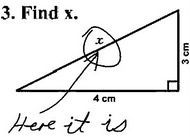Walking is good for your brain.
How to Keep Your Aging Brain Fit: Aerobics
Forget Crossword Puzzles -- Study Says 3 Hours of Exercise a Week Can Bolster Memory, Intellect
By Sharon Begley for the Wall Street Journal, November 16, 2006
According to a new study, the brain's long, slow decline may not be inevitable. For the first time, scientists have found something that not only halts the brain shrinkage that starts in a person's 40s, especially in regions responsible for memory and higher cognition, but actually reverses it: aerobic exercise.
As little as three hours a week of brisk walking apparently increases blood flow to the brain and triggers biochemical changes that increase production of new brain neurons.
As brains age, normal wear and tear starting in middle age causes them to process information more slowly, which means it takes longer to make judgments and grasp complex information. Older brains also take longer to switch from one task to another and are less adept at "multitasking" (such as driving while simultaneously tuning the radio and checking the tailgater).
A number of earlier studies showed that elderly people who take up aerobic exercise show improved cognitive function after a few months... Their working memory is better, they are nimbler at switching between mental tasks, and they can screen out distractions better than people who did not get exercise training.
As little as three hours a week of aerobic exercise increased the brain's volume of gray matter (actual neurons) and white matter (connections between neurons) ... "after only three months ... the people who exercised had the brain volumes of people three years younger."
Studies in both people and animals have linked increases in brain volume (which occur with some drugs) to improvements in thinking, remembering, cognitive flexibility (thinking outside the box) and perseveration (not getting stuck on one thought).
Gray matter increased most in the frontal lobes, the seat of high-order thinking such as attention and memory. White matter increased most in the corpus callosum. This is the bundle of neurons that connects the right brain and the left, and whose deterioration with age is thought to be responsible for slower thinking. With better connections, the hemisphere that is carrying out some task can send signals to the other side to pipe down, making for better cognitive efficiency.
"This is the first time anyone has shown that exercise increases brain volume in the elderly," says Dr. Kramer. "It suggests that aerobic exercise can stave off neural decline, and even roll back some normal age-related deterioration of brain structure."
How might exercise work this magic? Studies in lab animals show that exercise raises blood levels of a molecule called IGF-1 (for insulin-like growth factor). Normally, IGF-1 does not cross the blood-brain barrier, explains Prof. Gage, but "with exercise it does." IGF-1 increases blood flow, which is good for brain neurons. Even more important, it induces neural stem cells to morph into actual neurons and other functional brain cells. The hippocampus, a structure that is crucial to forming new memories, is especially amenable to the benefits of IGF-1.
With more gray matter and white matter, "the brain is more interconnected, more plastic and more adaptive to change," Prof. Kramer says.
Technorati Tags: Aging, Brain, Function, Exercise, Aerobics, Health



 A few of my daughter
Melina's great posts:
A few of my daughter
Melina's great posts:








1 Comments:
Thanks for posting the article. That is why I work out. Big muscles and brains. Great combo.
Post a Comment
<< Home